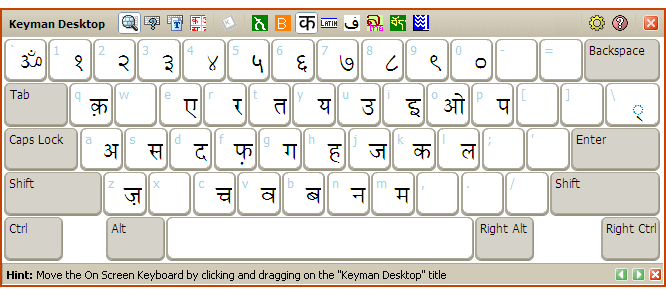The On Screen Keyboard
The On Screen Keyboard displays automatically when you select a Keyman keyboard layout. You can change this behaviour in Keyman Desktop Configuration.

To manually display the On Screen Keyboard:
Click on the Keyman Desktop icon
 in the system tray.
in the system tray.From the Keyman Desktop menu, select On Screen Keyboard.
The On Screen Keyboard is displayed by default in the last position it was used. It will be displayed initially in the bottom right hand corner of the screen.
The Toolbar
Along the top of the On Screen Keyboard is a toolbar.

Any of the following buttons may appear on the toolbar:
|
Icon |
Button Name |
Description |
|
|
View On Screen Keyboard |
Switches to the keyboard view for the selected Keyman Desktop keyboard layout. |
|
|
View Keyboard Usage |
Switches to the usage view for the selected Keyman Desktop keyboard layout. This view gives some basic tips on how to start using your selected keyboard layout, with links to full help for that keyboard layout. |
|
|
View Font Helper |
Switches to the Font Helper tool. |
|
|
View Character Map |
Switches to the Character Map tool. This tool is only available in Keyman Desktop Professional. |
|
|
Switch Keyman Off |
Switches your keyboard layout back to the default Windows layout. To use a Keyman Desktop keyboard layout again, you must select it from the Keyman Desktop Menu or from the On Screen Keyboard toolbar. |
|
|
Select Keyboard Layout |
This icon will only appear if there is not enough room on the On Screen Keyboard Toolbar to display all your installed keyboard layouts. When available, it displays a menu from which you can activate any installed keyboard layout. You can hide this icon by resizing the On Screen Keyboard. |
|
|
Open Keyman Configuration |
Opens Keyman Configuration, where you can install or uninstall keyboard layouts and change various options. |
|
|
Open Help |
Opens Keyman Desktop Help. |
|
|
Close On Screen Keyboard |
Closes the On Screen Keyboard but does not exit Keyman Desktop. The On Screen Keyboard can be displayed again by following the instructions at the top of this help topic. |
Toolbar Options
Right clicking on the On Screen Keyboard will display a menu with the following options:
|
Fade When Inactive |
If this option is enabled, the On Screen Keyboard appears partially transparent when the mouse is not over it. This option works best if you move your mouse away from the On Screen Keyboard slowly. |
|
Show Toolbar |
This option hides or displays the toolbar at the top of the On Screen Keyboard. |
|
Save as Web Page... |
This option saves the keyboard view of the current keyboard layout as a web page for easy reference. The new web page will include diagrams for every state of the current keyboard layout, including shift states. |
|
Print... |
This option prints the keyboard view of the current keyboard layout for easy reference. The printout will include diagrams for every state of the current keyboard layout, including shift states. |
The Hint Bar
At the bottom of the On Screen Keyboard, a hint bar shows handy tips on how to use Keyman Desktop and access some of the more advanced features available. The hint bar will slowly cycle through the available hints, or you can use the arrow buttons on the right of the hint bar to cycle through the hints yourself.
You can close the hint bar by clicking the X icon on the right hand side of the hint bar. This X icon is not the same as the Close On Screen Keyboard button at the top of the window!
To access the hint bar again, open Keyman Configuration, Options tab and click Reset Hints.
Using the On Screen Keyboard
To enter text using the On Screen Keyboard:
Position your text cursor where you want to type in your application.
On the On Screen Keyboard, click Shift, Ctrl, or Alt if you need them to type your desired character.
Example: if you wish to use the On Screen Keyboard to type the percent symbol (%) and you are using the standard US English layout, you would click Shift first because the percent symbol requires the Shift key.
On the On Screen Keyboard, click the key with the character you want to enter.
To select a keyboard layout from the On Screen Keyboard:
Click on the icon for the keyboard layout in the toolbar of the On Screen Keyboard.
If the On Screen Keyboard is too small to display the icons of all the installed keyboard layouts, a dropdown menu icon will be visible. Clicking on this will show a list of all the installed keyboard layouts from which you can select the one you want.
Resizing and moving the On Screen Keyboard
Resize the On Screen Keyboard by clicking and dragging on a corner of the On Screen Keyboard window.
Note
When the keyboard view is selected, the On Screen Keyboard will only resize according to the proportions of the keyboard.Move the On Screen Keyboard around the screen by clicking anywhere on the toolbar not covered by a button.












